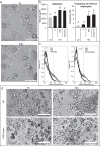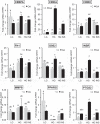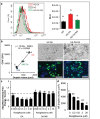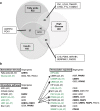Insulin prevents fatty acid induced increase of adipocyte size
- PMID: 35946137
- PMCID: PMC9450899
- DOI: 10.1080/21623945.2022.2107784
Insulin prevents fatty acid induced increase of adipocyte size
Abstract
Metabolic disorders related to obesity are largely dependent on adipose tissue hypertrophy, which involves adipocyte hypertrophy and increased adipogenesis. Adiposize is regulated by lipid accumulation as a result of increased lipogenesis (mainly lipid uptake in mature adipocytes) and reduced lipolysis. Using realtime 2D cell culture analyses of lipid uptake, we show (1) that high glucose concentration (4.5 g/L) was required to accumulate oleic acid increasing lipid droplet size until unilocularization similar to mature adipocytes in few days, (2) oleic acid reduced Peroxisome-Proliferator Activated Receptor Gamma (PPARG) gene transcription and (3) insulin counteracted oleic acid-induced increase of lipid droplet size. Although the lipolytic activity observed in high versus low glucose (1 g/L) conditions was not altered, insulin was found to inhibit oleic acid induced gene transcription required for lipid storage such as Cell Death Inducing DFFA Like Effectors (CIDEC) and G0S2 (G0 switch gene S2), possibly through PPARA activity. Although this signalling pathway requires more detailed investigation, the results point out the differential mechanisms involved in the pro-adipogenic effect of insulin in absence versus its protective effect on adiposity in presence of oleic acid uptake.Abbreviations: AICAR, 5-Aminoimidazole-4-carboxamide-1-D-ribofuranoside; AMPK, AMP-Activated protein kinase, ASCs, adipose stem cell; ATGL, adipose triglyceride lipase; BSA, Bovine serum albumin; CEBPA, CCAAT enhancer binding protein alpha; CIDEs, Cell Death Inducing DFFA Like Effectors; dA, differentiated adipocyte; DMEM, Dulbecco's Modified Eagle's Medium; FABPs, Fatty Acid Binding Proteins; FAT/CD36, Fatty acid translocase; FCS, Foetal calf serum; FN1, fibronectin 1; FFA, free fatty acid; G0S2, G0 switch gene S2; GLUTs, Glucose transporters; GPR120, G protein-coupled receptor 120; HG, high glucose; HSL, hormone sensitive lipase; INSR, insulin receptor; LG, low glucose; OA, oleic acid; PBS, Phosphate buffer saline; PPARs, Peroxisome-Proliferator Activated Receptors; PKA, Protein kinase cyclic AMP-dependent; PKG, Protein kinase cyclic GMP dependent; PTGS2, cytochrome oxidase 2; RTCA, realtime cell analysis; TG, triglyceride.
Keywords: Adipocyte; adiposize; lipid uptake; lipogenesis; lipolysis; realtime.
Conflict of interest statement
No potential conflict of interest was reported by the author(s).
Figures











Similar articles
-
Pathways commonly dysregulated in mouse and human obese adipose tissue: FAT/CD36 modulates differentiation and lipogenesis.Adipocyte. 2015 Jan 26;4(3):161-80. doi: 10.4161/21623945.2014.987578. eCollection 2015 Jul-Sep. Adipocyte. 2015. PMID: 26257990 Free PMC article.
-
Adipocytes as lipid sensors of oleic acid transport through a functional Caco-2/HT29-MTX intestinal barrier.Adipocyte. 2019 Dec;8(1):83-97. doi: 10.1080/21623945.2019.1580842. Epub 2019 Mar 23. Adipocyte. 2019. PMID: 30905315 Free PMC article.
-
Zyflamend, a unique herbal blend, induces cell death and inhibits adipogenesis through the coordinated regulation of PKA and JNK.Adipocyte. 2020 Dec;9(1):454-471. doi: 10.1080/21623945.2020.1803642. Adipocyte. 2020. PMID: 32779962 Free PMC article.
-
Fat Cell and Fatty Acid Turnover in Obesity.Adv Exp Med Biol. 2017;960:135-160. doi: 10.1007/978-3-319-48382-5_6. Adv Exp Med Biol. 2017. PMID: 28585198 Review.
-
Lipid Storage, Lipolysis, and Lipotoxicity in Obesity.Adv Exp Med Biol. 2024;1460:97-129. doi: 10.1007/978-3-031-63657-8_4. Adv Exp Med Biol. 2024. PMID: 39287850 Review.
Cited by
-
Response of Primary Human Adipocytes to Fatty Acid Treatment.J Cell Mol Med. 2025 May;29(10):e70622. doi: 10.1111/jcmm.70622. J Cell Mol Med. 2025. PMID: 40418213 Free PMC article.
-
In vitro and in vivo toxicity of carbon dots with different chemical compositions.Discov Nano. 2023 Sep 8;18(1):111. doi: 10.1186/s11671-023-03891-9. Discov Nano. 2023. PMID: 37682347 Free PMC article.
-
Unraveling the complexities of diet induced obesity and glucolipid dysfunction in metabolic syndrome.Diabetol Metab Syndr. 2025 Jul 22;17(1):292. doi: 10.1186/s13098-025-01837-y. Diabetol Metab Syndr. 2025. PMID: 40696355 Free PMC article. Review.
-
FABP4 Controls Fat Mass Expandability (Adipocyte Size and Number) through Inhibition of CD36/SR-B2 Signalling.Int J Mol Sci. 2023 Jan 5;24(2):1032. doi: 10.3390/ijms24021032. Int J Mol Sci. 2023. PMID: 36674544 Free PMC article.
References
MeSH terms
Substances
LinkOut - more resources
Full Text Sources
Other Literature Sources
Medical
Research Materials
Miscellaneous
